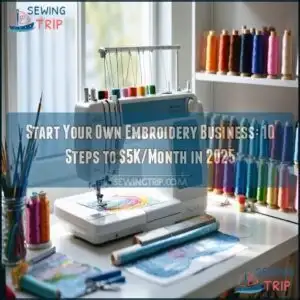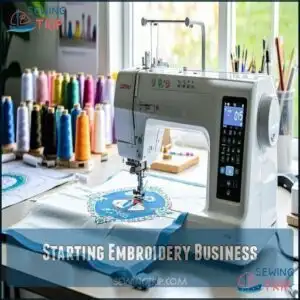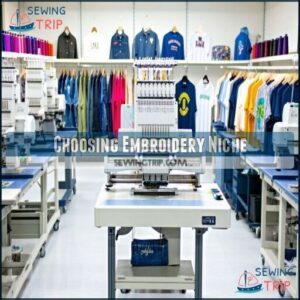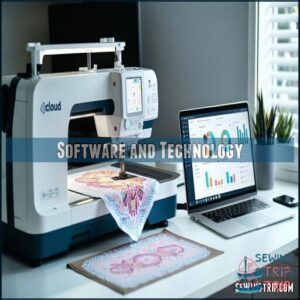This site is supported by our readers. We may earn a commission, at no cost to you, if you purchase through links.
 Starting your own embroidery business is simpler than you’d think—just a blend of creativity, planning, and the right tools.
Starting your own embroidery business is simpler than you’d think—just a blend of creativity, planning, and the right tools.
First, find your niche, like custom shirts or personalized gifts, and research what customers want.
Next, invest in a good embroidery machine, quality supplies, and software to create designs.
Don’t forget the business basics: licenses, a bank account, and a clear pricing strategy.
Social media is your ally—use it to show off your work and connect with clients.
It’s a mix of art and hustle, but with some effort, you can turn threads and needles into steady income.
Ready to stitch success?
Table Of Contents
Key Takeaways
- Find your niche, like custom gifts or corporate branding, to stand out in a competitive market.
- Invest in the right equipment, quality supplies, and user-friendly software to ensure consistent results.
- Market your work creatively through social media, a professional website, and local networking.
- Focus on excellent customer service and quality control to build a loyal customer base.
Starting Embroidery Business
You can transform your creativity into a profitable business with embroidery, a craft that’s projected to reach a $5.9 billion market by 2028.
Starting your own embroidery venture requires identifying lucrative niches like corporate branding or personalized gifts.
Turn your creativity into profit by focusing on high-demand niches like personalized gifts or corporate embroidery.
While conducting thorough market research will help you understand customer preferences and set yourself apart from competitors, focusing on lucrative niches is key to success.
Identifying Profitable Niches
Finding the right profitable niches is essential for your embroidery business success.
Several untapped demographics await your creative touch. Through smart market research and competition analysis, you’ll discover where your skills meet market demand.
Here are 4 highly profitable niches:
- Corporate branding for local businesses
- Athletic teams and university Greek organizations
- Wedding and bridal party customization
- Personalized baby products and pet accessories
Conducting Market Research
Now that you’ve spotted potential profitable niches, it’s time to verify them with solid market research. You’ll need to understand your target audience inside out.
Don’t skip this step—proper demand assessment guarantees you’re not embroidering in the dark, and it’s crucial for emerging opportunities and to define your ideal buyer with the right market trend analysis.
Analyzing Competitors
Now that your market research is complete, it’s time to size up your competition. Understanding who you’re up against helps you carve out your unique position in the embroidery landscape.
Analyze your competitors with these four steps:
- Compare pricing structures across similar services
- Identify gaps in their service offerings
- Evaluate their marketing strategies and customer perception
- Document their strengths/weaknesses to find your competitive advantage
By following these steps, you can gain a deeper understanding of the market and make informed decisions to establish your brand in the embroidery industry, focusing on your unique position.
Choosing Embroidery Niche
You’ll boost your embroidery business success by selecting a specific niche that matches your skills and market demand.
Finding your sweet spot among custom apparel, corporate branding, or personalized gifts will help you stand out in the $5.9 billion industry.
Attracting the right customers will be easier when you have found your niche, and this will contribute to your overall success.
Custom Apparel
Custom apparel consistently ranks as the most popular embroidery niche.
You’ll create unique Tshirts, jackets, and polo shirts that stand out from mass-produced options. Select quality fabrics and master printing techniques to deliver premium results.
Stay updated on fashion trends while perfecting your apparel design skills. Custom embroidery offers endless creative possibilities for apparel customization, allowing you to transform ordinary clothing into wearable art with distinctive brand integration, and this is a key aspect of creating premium results.
Corporate Branding
While custom apparel serves individuals, corporate branding opens doors to larger, consistent orders.
Companies need Brand Embroidery on everything from uniforms to promotional items. Your embroidery business can thrive by handling Logo Digitizing for local businesses—think employee uniforms, corporate gifts, and event merchandise.
With proper Uniform Design skills, you’ll land recurring clients. Create a business plan targeting this audience; companies value quality and reliability over bargain prices when showcasing their brand identity.
To guarantee quality results, consider the software’s auto-digitizing capabilities.
Personalized Gifts
While corporate branding can establish steady income, personalized gifts offer a heartfelt avenue for your embroidery business.
Gift personalization continues to trend upward as consumers seek unique keepsakes with sentimental value.
Profitable personalized gift opportunities include:
- Custom baby blankets for new parents (always in demand)
- Monogrammed wedding items (high-value purchases)
- Commemorative items for milestone birthdays and anniversaries
Custom embroidery designs turn ordinary items into treasured mementos that recipients will cherish for years, making them a great way to create unique keepsakes.
Setting Up Business
You’ll need to establish a legal foundation for your embroidery business by obtaining licenses, registering your business name, and opening a dedicated bank account.
Taking these steps now will save you headaches later, allowing you to focus on turning beautiful stitches into actual profits.
Obtaining Licenses
Now that you’ve identified your embroidery niche, it’s time to handle the paperwork.
You’ll need various licenses and permits to operate legally, including federal requirements that vary based on your specific business activities.
While state regulations typically cover more areas, including arts and crafts, don’t forget local permits—they’re often overlooked but equally important.
Check with your county clerk’s office for business compliance details, as a sellers permit is typically mandatory for collecting sales tax.
Registering Business
Now that you’ve secured your licenses, it’s time to make your embroidery business official.
Select a memorable Business Name that reflects your style. Choose your Legal Structure (sole proprietorship or LLC) based on liability needs.
Complete your EIN Application online through the IRS website. File State Registration paperwork and pay required fees.
Don’t forget to handle employer registration if you’ll hire help. This paperwork puts you on the path to wholesale pricing access.
Opening Bank Account
Now that your business is registered, it’s time to open a business bank account. This step separates your personal and business finances, making tax season much less of a headache.
Compare account types and bank fees from different institutions. Look for features like online banking, loan access, and credit building opportunities.
Many banks offer special business accounts with perks suited to small business owners like you.
Essential Equipment
You’ll need the right tools to turn your embroidery passion into a profitable business, and it doesn’t have to break the bank.
Your success hinges on selecting quality machines, essential supplies, and user-friendly software that match your budget and production goals.
Embroidery Machines
Now that you’ve registered your business, let’s get you equipped with the right embroidery machine—your business’s workhorse.
Selecting the perfect machine depends on your production needs and budget:
- Single-needle machines are ideal for beginners, requiring manual thread changes for multi-colored designs
- Multi-needle commercial machines boost efficiency with automated color changes
- Computerized models offer touchscreens and wireless design uploads
- Industrial machines handle large-scale projects without constant supervision
Remember: proper machine maintenance extends your equipment’s lifespan and guarantees consistent stitch quality. There are various specialized machine options available today, which can help you find the perfect fit for your business needs.
Supplies and Materials
Now that your embroidery machine’s ready to hum, you’ll need quality supplies to bring your designs to life.
Stock up on these essentials:
| Supply Type | Must-Haves | Where to Source |
|---|---|---|
| Thread Types | Polyester, Rayon, Metallic | Madeira, Isacord, Marathon |
| Stabilizer Variety | Cutaway, Tearaway, Water-soluble | Wholesalers like AllStitch |
| Wholesale Blanks | Hats, Shirts, Bags | SanMar, S&S Activewear |
Understanding different thread compositions is vital for achieving the desired look and durability.
Don’t skimp on embroidery threads—they’re literally what holds your business together!
Software and Technology
Three essential software solutions will power your embroidery business to success.
Invest in quality digitizing software like Hatch Embroidery or WilcomWorkspace to transform designs into stitch-ready files. Look for programs that offer autodigitizing software capabilities, extensive design libraries, and cloud integration.
Modern embroidery machine automation features save time, while mobile management apps let you run your business from anywhere. These machines often feature on-board editing for real-time customization.
Your embroidery software investment will quickly pay for itself in efficiency gains, as it allows for real-time customization and provides access to extensive design libraries, making it a valuable asset for your embroidery business.
Pricing Strategies
You’ll need smart pricing strategies to turn your embroidery passion into a profitable $5K/month business.
Setting the right prices means calculating your true costs and knowing what customers will pay, without leaving money on the table.
Like I did when I first started charging only $5 for designs that took hours to create, which was a significant mistake in terms of smart pricing.
Calculating Costs
Now that you’ve secured your equipment, you’ll need to track every penny to guarantee profitability.
Understanding your exact costs is the foundation of sustainable pricing.
Calculate these five essential expense categories:
- Material Costs – Thread, stabilizer, and blanks ($5,000-$15,000 initially)
- Labor Costs – Your time or employee wages
- Equipment Depreciation – Machine value divided by expected lifespan
- Overhead Expenses – Rent, utilities, software subscriptions
- Startup Costs – One-time expenses like business registration ($300)
Determining Prices
Most successful embroiderers use two primary pricing methods for profitable outcomes.
Set your stitch count rates between $0.50-$1.50 per thousand stitches based on design complexity, with small designs at $2.25 and larger ones at $7.50.
Alternatively, calculate hourly rates around $25-35 to cover material costs and guarantee decent profit margins.
Factor in wholesale pricing opportunities while keeping cost of goods sold under 50% of revenue for sustainable profitability.
Competitor Analysis
While setting prices, knowing your competitors gives you a competitive edge in the booming embroidery market.
Conduct thorough market research with these five steps:
- Mystery shop your competitors to compare pricing structures
- Note their bundle pricing and bulk discounts
- Identify unique service offerings that justify premium pricing
- Analyze their product differentiation strategies
- Review customer feedback to find gaps you can fill
This industry knowledge helps you position your business with strategic pricing that balances profitability and market competitiveness.
Marketing Embroidery
You’ll need to showcase your embroidery work where potential customers can find it, whether through a professional website, active social media presence, or local networking events.
Getting your beautiful stitches in front of the right eyes isn’t just about posting pretty pictures—it’s about creating a strategic marketing plan that connects your specific embroidery skills with the people willing to pay for them, which requires a deep understanding of your target audience and how to effectively use social media.
Building Online Presence
Your embroidery business needs a solid online presence.
Start with a professional website setup featuring your services, portfolio, and an online shop.
Invest in Website SEO and E-commerce Integration to attract customers.
Use Content Marketing like blogs to share tips or designs.
Combine Online Advertising with targeted Email Campaigns to drive traffic.
Consider the importance of embroidery website design for attracting customers.
Online selling thrives on smart strategy!
Social Media Marketing
Boosting your embroidery business through social media marketing starts with creating a standout social media presence.
Focus on:
- Sharing behind-the-scenes content to build connection.
- Collaborating with influencers for outreach.
- Using paid advertising to extend reach.
- Tracking analytics to tweak posts effectively.
Think of it as stitching your brand story online—each post adds to the bigger picture!
Networking Strategies
Don’t underestimate the power of a good chat. Attend business networking events or industry events to meet potential partners.
Join online forums and engage with suppliers. Build connections with local businesses for partnerships.
Offer referral programs to encourage word-of-mouth marketing. To maximize reach, define your target audience for customized marketing.
Networking isn’t just about handshakes—it’s about fostering business relationships that’ll keep your embroidery business thriving, which is the key to a successful venture.
Managing Finances
Keeping your embroidery business finances in order isn’t as tricky as it sounds.
With a solid plan for tracking expenses, managing cash flow, and handling taxes, you’ll set yourself up for steady growth.
Budgeting and Accounting
How do you keep your finances in check?
Start by tracking expenses to control costs and boost profit margins. Use bookkeeping software for inventory accounting and financial forecasting.
Open business accounts, get a tax ID, and don’t overlook tax deductions.
Protect your success with business insurance. Smart financial management today means fewer surprises tomorrow—like discovering missing stitches in your budget!
Managing Cash Flow
Tracking expenses is like keeping a tidy closet—you’ll thank yourself later.
Use bookkeeping software to monitor payments and pricing, ensuring healthy profit margins. Manage inventory wisely to avoid overstocking.
Negotiate payment terms with clients to maintain steady cash flow. Revenue forecasting helps you plan ahead, while separate business accounts simplify budgeting and financial management.
Small steps, big rewards, and taking these steps can lead to big rewards.
Tax Compliance
When handling business taxes, staying compliant is key.
A solid tax plan saves you headaches and money.
Focus on:
- Tax deductions for equipment and supplies.
- Estimated taxes for quarterly filing to avoid penalties.
- Getting a sales tax license for proper collection.
- Managing payroll taxes if you have employees.
- Using reliable tax software to simplify income tax filing.
Plan smart, save big!
Growing Embroidery Business
To grow your embroidery business, focus on expanding services and improving efficiency to handle more orders without compromising quality.
Managing growth effectively guarantees you meet rising demand while keeping customers happy and coming back for more, which is crucial for expanding services and improving efficiency.
Expanding Services
When growing, expanding your embroidery services can spark serious business growth.
Offer Service Bundling—combine discounts for bulk orders. Try Product Diversification, like tote bags or custom hats, to target different niches.
Educate clients on Customization Options, so they know what’s possible.
| Strategy | Benefit | Example |
|---|---|---|
| Service Bundling | Higher customer loyalty | Corporate branding kits |
| Product Diversification | Attract new markets | Personalized home decor |
| Customization Options | Upsell opportunities | Unique wedding gifts |
Increasing Efficiency
Boost business efficiency by embracing workflow optimization and process automation.
Use automation tools for repetitive tasks like order tracking and invoicing.
Simplify the embroidery process with design streamlining software and proper inventory management.
Cut waste by organizing materials smartly, and remember, time management gets easier when everything has its place—fewer hiccups mean happier clients and more stitched success with proper inventory.
Managing Growth
You’ve boosted efficiency—now it’s time to focus on smart growth. Scaling operations means knowing when to invest in team building or automation tools.
Keep inventory management under control to avoid overstocking or shortages. Business growth strategies like customer retention programs are gold for steady income during business scaling.
With clear business productivity goals, you’ll master business expansion with ease.
Providing Excellent Service
You can’t grow a successful embroidery business without happy customers, so focus on delivering consistent quality and meeting deadlines.
When you go the extra mile, like offering quick responses or fixing mistakes promptly, your clients will notice—and come back for more, which is crucial for a successful embroidery business.
Customer Satisfaction
Customer satisfaction isn’t just nice — it’s your business lifeline.
Delighted customers aren’t just clients—they’re your best advertisement and the heartbeat of your business.
Keep customers smiling by focusing on these essentials:
- Ask for customer feedback often to improve your service.
- Handle hiccups with quick service recovery and clear communication channels.
- Build relationships through personalization options customized to them.
- Reward loyalty with simple loyalty programs, turning one-time buyers into long-term fans.
Quality Control
How do you guarantee exceptional quality? Start with stitch consistency and design accuracy—always double-check your work.
Inspect materials for defects before stitching, and watch for stitchout issues caused by machine wear and tear. Prevent defects with routine maintenance and quality assurance steps.
To further minimize errors, inspect for uneven tension after each step.
Continuous Improvement
Quality control keeps customers happy, but growth thrives on continuous improvement.
Embrace customer feedback and trend monitoring to enhance services.
Automate processes for efficiency and reduce waste to save on costs.
Diversify your skills through continuous learning, ensuring business resilience.
Focus on process optimization and quality assurance to streamline operations, driving business optimization while staying adaptable in the ever-changing embroidery market.
Maintaining Success
Success isn’t just about reaching your goals—it’s about staying there. Keep learning, adapting, and tracking your progress to make sure your business thrives for years to come.
Staying Up-to-Date
Staying up-to-date in the embroidery business keeps you ahead of the curve.
Watch for fresh ideas and tools to stay competitive.
- Learn new techniques to enhance your skills.
- Follow design trends for customer appeal.
- Upgrade software for smoother workflows.
- Explore material innovations to improve quality.
- Attend industry events to network and learn, which helps you stay competitive and aware of fresh ideas.
Adapting to Change
Change is constant—embrace it with business agility. Whether it’s new technologies, shifting markets, or evolving trends, staying flexible keeps you ahead.
Listen to customer preferences and ride those economic fluctuations like a seasoned surfer.
Business innovation and transformation aren’t just buzzwords; they’re survival tools. Adapt quickly, and you’ll thrive while others stumble.
In embroidery, resilience is your strongest stitch!
Evaluating Progress
You’ve navigated changes—now it’s about measuring progress.
Keep an eye on key performance metrics like sales trends and customer feedback. Review financial metrics monthly to spot patterns.
Business evaluation isn’t about perfection; it’s about improvement. Analyze market adaptability and realign goals as needed.
Treat business analysis as a roadmap—it keeps your embroidery business heading toward success, not circling aimlessly.
Frequently Asked Questions (FAQs)
How do I build my embroidery business?
Focus on finding your niche, like custom gifts or corporate branding.
Build an engaging online presence, showcase quality designs, and connect with local businesses.
Invest in great equipment and offer exceptional service to grow loyal customers.
Can you start an embroidery business from home?
Starting an embroidery business from home is like stitching your dreams into reality.
You can turn a spare room into a creative workshop, keeping costs low while offering custom designs to friends, events, and businesses.
How to launch a successful embroidery business?
Launch your embroidery business by crafting a solid plan, investing in quality equipment, and finding your niche.
Market creatively with social media and word-of-mouth.
Deliver exceptional designs, and customer satisfaction will keep you thriving!
How do I start a sustainable embroidery business?
The embroidery industry is projected to hit $9 billion by 2028, so why not get started?
Choose eco-friendly materials, build a sustainable workspace, define your niche.
Market your business with authenticity and creativity!
How do I become an embroidery business owner?
Get started with embroidery by learning the craft, finding your niche, and crafting a business plan.
Invest in quality equipment, build an online presence, and network locally.
Treat every project like art—let passion guide you!
How do I start an embroidery company without experience?
You don’t need experience—start small with a reliable machine, watch online tutorials, and practice.
Focus on simple designs, learn as you go, and explore profitable niches like custom gifts or corporate branding.
What can I embroider to sell?
Imagine this: your designs turning everyday items into treasures.
Embroider hats, jackets, tote bags, baby blankets, or custom patches.
Add charm to wedding gifts, aprons, or even pet collars.
The market loves personal, creative touches!
What is the best embroidery machine to start a business?
The Brother PE800 is a fantastic choice for beginners.
It’s user-friendly, offers a large embroidery field, and includes plenty of built-in designs.
You’ll get premium features without emptying your wallet—perfect for starting out!
How difficult is embroidery?
Embroidery isn’t too hard to learn, but like any skill, it takes practice.
Start with simple designs to build confidence.
Mistakes happen, but they’re part of the process—embrace them and enjoy creating!
Is the hand embroidery business profitable?
Running a hand embroidery business can absolutely be profitable, especially if you focus on unique designs and personalized items.
Customers crave the handmade touch, and with fair pricing and smart marketing, you’ll stand out.
Conclusion
Starting your own embroidery business is like stitching the first thread—small steps lead to big results.
With the right niche, good tools, and a clear plan, you’re set to turn creativity into cash.
Keep learning, adapt to trends, and build strong client connections through quality work.
Marketing on social media can boost your reach.
Success won’t happen overnight, but with consistency and hustle, you can hit $5K a month and enjoy doing what you love.




















